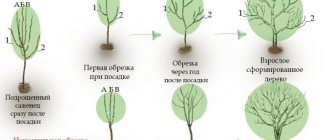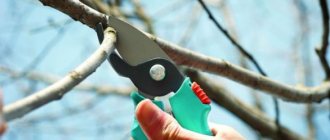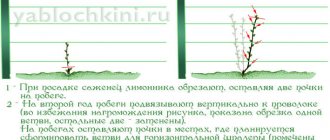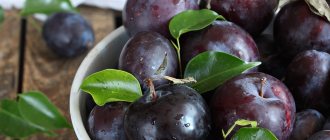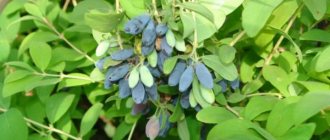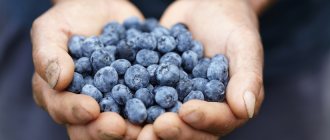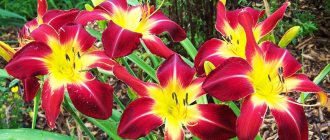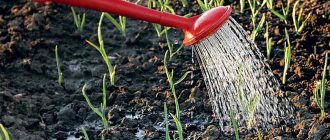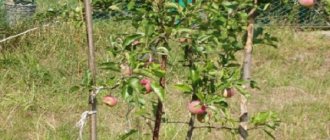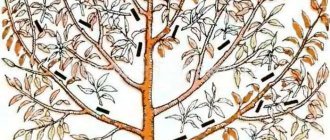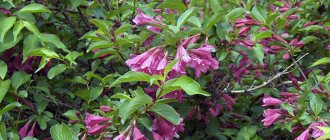Is pruning necessary?
Caring for barberry in the garden includes pruning. Many novice gardeners do not understand whether this procedure is mandatory or not. This largely depends on the type of pruning itself:
- sanitary cleaning should be done every year so that the plant does not waste energy and nutrients on dried or painful branches;
- shaping is done solely at the request of the gardener and his plans for the shrub;
- Anti-aging is recommended to improve the decorative qualities of the bush.
Barberry in open ground
Depending on the gardener’s plans, it is worth deciding in which cases pruning is required and in which cases it can be avoided. Without proper care, ordinary barberry will quickly spread throughout the entire area due to the possibility of reproduction through root suckers.
Important! When pruning, it is necessary to protect your hands from sharp thorns. To do this, you need to prepare thick gloves. It is recommended to sharpen the tool well (it is advisable to use one with long handles and thick blades), since the branches are quite strong.
Preparing barberry for winter in the Moscow region
This region belongs to a temperate climate, so the procedure for caring for the plant before winter is not too complicated. To prepare barberry for the winter in the Moscow region, you should do the following:
- clear the area around the bushes from debris;
- feed the plant;
- dig up the soil under the bushes;
- carry out sanitary pruning;
- mulch tree trunk circles.
Barberry is fertilized with humus or compost. The circles are mulched with loose peat, compost or dried leaves.
The climate in the Moscow region is quite mild, so it is not necessary to cover the plant from above. This is worth doing if the bushes are younger than 5 years old. Then, when preparing barberry for winter in the fall, when the first frost sets in, it is better to cover the bushes with spruce branches.
It is enough to mulch bushes older than 5 years and strengthen the root collar by surrounding it with black soil, leaves, straw or pine needles.
Anti-aging barberry pruning
Anti-aging pruning of barberry should be done in the spring. It is required for 8-10 year old plants, the decorative value of which has significantly decreased. Removing old shoots will give the plant new life, the plant will come to life before our eyes and within a year it will be possible to start forming shrubs.
Barberry Erecta - planting and care, description
After pruning, the shoots begin to grow vigorously. You can remove branches on any type of planting: both on a single plant and on a hedge or border. Trimming barberry involves removing all shoots.
Note! Old shoots should be cut off at the surface of the ground, and new shoots should be shortened to 1/3 of their length. The cut areas must be treated with antiseptic solutions to protect against fungal diseases.
Scheme of anti-aging pruning of barberry
Circuits and technology
Proper pruning of shrubs is quite simple. Its branches grow almost vertically and rarely get tangled. But giving thickened barberry the required shape can be difficult.
Features of pruning a young bush
The first pruning of a young bush is carried out in the first spring after planting. Choose one of the strongest shoots and shorten it to the first bud. Cut out all weak branches. Over the summer, the shrub will produce abundant growth. In this form he will go away for the winter. The gardener only needs to remove damaged or diseased branches.
Next spring, the shrub is “planted on the stump.” All branches are cut low, leaving high stumps. During the growing season, the awakened buds will give abundant growth. The rule for pruning young barberry: the operation is carried out only in the spring, in the fall the bush is left alone.
Anti-aging pruning
Old bushes (12 years or more) require anti-aging pruning. It is recommended to proceed as follows:
- cut out all old shoots of dark color without leaving stumps;
- weak young ones should also be removed;
- cut out some of the young ones, leaving stumps;
- shorten the remaining young shoots by 1/3.
You should not be afraid of removing shoots too radically: barberry will quickly respond to it and grow new branches. In this way, you can extend the life and fruiting of the shrub in the garden.
Wellness
Healthy pruning is carried out at any time of the year. During this process, all broken and dried branches are removed. It is definitely recommended to carry out the operation after strong winds, heavy snowfalls, and freezing rains.
Formative
It is simple to form barberry: all its branches grow almost vertically. The gardener is only required to promptly remove old and tangled shoots. It must be taken into account that some barberries produce abundant root shoots. It also needs to be cut close to the ground. Barberry easily recovers after pruning of any intensity, so it can be given any shape using a topiary frame.
Features of pruning various types of barberry
If barberry is left alone, it will form into a disheveled ball. Landscape designers take this feature into account: most often they cut barberry in the form of a ball, cone or pyramid.
Sometimes in the garden there are barberry bushes, trimmed in the form of a cube or rectangular parallelepiped. In this way a hedge is formed.
When planning an outline, the gardener must calculate the number of skeletal branches of the plant:
- for a spherical or cubic shape, 2-3 strong shoots are enough;
- a pyramid or cone involves 6-8 skeletal shoots of different lengths.
See also
Varieties and types of barberry with descriptions and characteristics, choice for regionsRead
It is impossible to give the required shape to a plant in one season. First, the gardener should determine the number and direction of the main branches, and next year, using a frame or template, complete the pruning.
Sanitary pruning of plants
Barberry Thunberg Atropurpurea - description of the variety
Sanitary pruning of barberry is carried out annually. In the process, you can also begin to form a crown. It is recommended to trim only healthy shoots, but do not be too zealous. Weak branches are removed completely.
The crown can be formed only in the second year of the plant’s life. In this case, it is worth familiarizing yourself with the diagram in order to make the correct haircut and not damage the flower. The procedure should be carried out in the spring, before the buds bloom, and before winter, when the harvest has already been harvested.
Next spring it is recommended to shorten the shoots to 10 cm above the ground. The procedure will increase the density of the bush, it will begin to branch. At the 3rd year of life, 15 cm of shoots are left above the soil level. For a single plant, this method of cutting barberry will allow it to be kept in a ball shape for a long time. Border plantings and hedges require this procedure.
Scheme of sanitary pruning of barberry
How to form barberry correctly
The formation of barberry begins in the second year of the bush’s life. In spring, all branches are shortened by 8-10 cm from the ground. This technique allows you to create a more luxuriant crown by autumn. The next season, shoots are cut 5 cm higher than the previous ones. In the case of individual planting, this procedure can be neglected, performing regular sanitary pruning only. When creating hedges, geometric shapes, border plantings, this pruning will be an annual necessity.
To give shape, the shrub is formed gradually. First, 3-4 main, skeletal branches are laid. Over time, the number is increased by adding two more skeletal branches. Thus, due to the different size of the shoots, it is possible to form a pyramidal-shaped barberry.
Attention! Barberry responds well to pruning. However, if the bush is significantly shortened, you should not count on a harvest.
Formation of the correct crown
Thuja hedge - pruning and shaping
Formative pruning of barberry can be done in summer and spring. In the spring, haircuts are carried out after sanitary pruning. In this case, it is necessary to remove the shoots that thicken the bush. It is also worth cutting off those branches that are located close to the ground.
Additional Information! Barberry tolerates shearing well, and therefore you don’t have to worry about its condition after surgery. If you combine pruning with proper care, the bush will not experience stress.
In summer, 2 prunings can be performed. The first is held in early June, the second – after 2 months. In this case, it is worth using a template, since cutting barberry into a cube or ball is quite difficult by eye, since these are regular shapes. When cutting for the first time, choose the width and height of the bush, cut off the branches that extend beyond the boundaries of the template. Then the growing shoots are simply removed, but you should adhere to the given shape.
Important! In the first few years (about 5), barberry may not bloom. The procedure is carried out after the ovary appears, and the plants are trimmed manually with pruners or scissors. If the bush is old enough or occupies a large area, you can use electric scissors.
Scheme of formative pruning of a plant
Is it possible to prune barberry bushes?
Barberry, if left to its own devices, grows low - up to 3-4 m, actively branches, but only fresh shoots bloom and bear fruit. This means that cutting off some of the shoots is not only possible, but necessary. There are several effects from this procedure:
- Clearing the site - dense thickets of branches with thorns are useful as protection from uninvited guests, but on the site it will be unnecessary;
- Improving appearance - spreading branches grow in disarray, a beautiful shape will have to be achieved;
- Increased fertility - each pruning increases the number of young shoots capable of bearing fruit.
The bushes tolerate pruning well, so the procedure does not harm the barberry at all; it only brings benefits if done according to the rules.
Why is barberry pruning important?
Why you need to prune shrubs:
- Without crown formation, this thorny shrub takes on an untidy shape.
- And picking berries from such plants is problematic: you have to protect your hands with gloves. And pests and fungal spores can overwinter on the remaining fruits.
- A well-formed bush decorates the site. Several plants planted in a row can serve as a hedge. But without timely intervention, the gardener risks getting painful scratches.
You cannot start pruning the bush: it is quite difficult to form a thickened crown.
Curly trimming
If you want to create sculptures from living plants, the shaping haircut changes to a curly one. It is held twice a year: at the beginning and end of summer. It is not difficult to form a barberry bush, since it does not require serious effort to obtain light geometric shapes.
For these purposes, guide rails are most often used, which are fixed vertically and horizontally around the bush in a certain size. Subsequently, branches that extend beyond the boundaries are pruned.
You can use not one plant, but several at once, to make it easier to create larger-scale structures. For a small cube, a couple of plants are enough, but if you need a larger size, then you should plant from 5 to 9 plants.
Additional Information! The most difficult thing is to form barberry with a ball, since you need a more complex design for the template. Most often, plywood or plastic is used, from which a semicircle is cut out and then attached to a pin. If this structure is rotated around its axis, it will form a ball.
After practicing on simple shapes, you will be able to create more complex ones. This is not very difficult. It is necessary to combine several simple shapes into one complex one, and then carry out the same procedures for curly trimming.
Curly pruning of barberry
WHEN TO PRUN FLOWERING SHRUBS?
Beautifully flowering shrubs are grown to decorate the area, which is why the main purpose of pruning is to make the bush bloom profusely.
According to the characteristics of pruning, flowering shrubs are divided into three groups:
The first group includes shrubs that do not form powerful shoots from the base. Every year they send out new shoots along the entire perimeter of the crown. Such shrubs include: viburnum, cotoneaster, barberry, magnolia, hibiscus and others. These shrubs require minimal pruning in the spring.
In the first years after planting, it is important to form a skeleton of strong branches, and then weak branches are removed every spring. For mature plants, it will be enough to just trim dry and diseased branches.
If necessary, you can remove a strong shoot to achieve a decorative look.
Photo: Example of magnolia pruning
The second group includes shrubs that produce color on last year's shoots. This species includes: weigela, deutzia, hydrangea, tamarix, kerria, mock orange, three-lobed almond, some types of spirea and others. Shrubs belonging to this group usually begin to bloom in spring or early summer. It is also worth considering the fact that these shrubs grow quickly, so they need to be planted no later than two or three years of age. These types of shrubs are pruned minimally in the spring, only damaged and dry branches are removed. Immediately after flowering, in the fall, faded branches are cut off and left strong and strong. In the future, every year after flowering, all faded branches are cut off. You also need to cut off a quarter of the old shoots almost at the root.
Photo: Example of pruning hydrangea
The third group includes shrubs that bloom on this year's shoots. Such shrubs include: spirea, David's buddleia, hydrangea and paniculata. In early spring, these types of shrubs are well pruned so that they can send out powerful shoots. If you do not prune them in the spring, then by autumn they will become very overgrown and will no longer bloom as much. In the first few years after planting, these types of shrubs are pruned lightly, giving them the opportunity to gain strength, and after that it will be necessary to prune them as much as possible every year.
Photo: Example of spirea pruning
Each shrub requires pruning; only in this case will it be able to produce a good harvest and bloom profusely. Don't be afraid to prune them; they recover very quickly and send out new shoots.
Pruning bushes in spring: Video
Source
Pruning barberry in spring and summer: features
The main difference between summer and spring pruning is the timing. In the spring, it is worth carrying out the procedure strictly before the buds appear so as not to harm the plant. In summer, decorative pruning can be done at any time, regardless of the month.
In spring, it is recommended to first trim those branches that did not survive the frost - they have dried out or rotted. In summer, only protruding branches that disrupt the overall picture are removed.
Important! If pruning was carried out due to the presence of pests or any disease, it is recommended to burn the branches immediately after cutting.
Care after pruning
Many people know how to cut Thunberg barberry, but not every gardener applies a number of measures that will help the plant recover after cutting. This is necessary for subsequent fruiting and growth.
Feeding
In the spring, after pruning, it is worth adding nitrogen to the soil. Each adult plant needs a bucket of organic matter, which is rotted manure or mature compost. It should be distributed in an even layer around the trunk. Gardeners often use fermented grass in liquid form for this purpose.
In summer and autumn it is worth adding potassium and phosphorus. These elements will allow the plant to better prepare for the upcoming cold weather. Substances can be found in inert flour or stove ash. If these fertilizers are not enough, it is also recommended to add a mineral complex.
After additional decorative pruning, you can apply liquid foliar fertilizer. In this case, you should use either potassium humate or the same fermented grass.
Cut care
If the sections have a diameter of more than half a centimeter, they need to be processed. Otherwise, fungal spores or insect larvae may enter the wounds. The infection will subsequently have to be treated for a long time, and if the diagnosis is delayed, the plant may even die.
Slice processing
You can coat the cuts with one of the following substances:
- garden antiseptic;
- garden pitch;
- oil paint;
- green solution.
If you properly treat the cut areas, they will be overgrown with bark in a short time, there will be no hollows in them, and they will not begin to rot.
Pest prevention
The most effective way to protect against pests is to treat branches and leaves with a soap solution. To prevent the development of various types of diseases, it is recommended to add colloidal sulfur and Bordeaux mixture to the soil. If spotting appears on the leaves, you should use products containing copper.
Barberry does not require constant care, but its use in landscape design requires constant trimming of the bushes, which is why at times you will have to arm yourself with tools with long handles and put on thick gloves on your hands. Don’t forget about proper care afterwards.
Caring for barberry in autumn
In order for the plant to develop well and maximize its decorative properties, next year after planting in the fall and pruning, you need to organize proper care for the seedling.
The crop needs watering, loosening and fertilizing. And although the shrub is unpretentious, it is necessary to regularly remove weeds around it, treat it against pests and diseases, and prune it.
Feeding
It is recommended to use products containing phosphorus and potassium as fertilizers. These substances will increase the frost resistance of the seedling, which will allow it to safely survive the winter months.
To get beautiful photos of barberry in the fall, it is enough to fertilize once every 3-4 years.
Treatment against diseases and pests
Although the plant is easy to care for, it does not have a strong immune system. If autumn pruning is not done correctly or the buds are damaged by insects, flowering may not occur, which means the plant will lose its decorative properties.
Common barberry is susceptible to powdery mildew. A characteristic whitish coating appears on its leaf blades. Gradually it becomes more dense, spreading not only along the leaves, but also on the shoots.
To destroy powdery mildew, it is recommended to use a soda-soap solution: 40 g of soap and 0.5% soda ash per 10 liters of water
Important! Treatment against powdery mildew should be carried out three times per season.
The main symptoms of rust are orange spots on the leaf plate. Without timely treatment, the leaves of the bush quickly wither and fall off. The disease can quickly spread to nearby bushes.
On the back of rust stains you can find a convex formation: fungal spores
Bordeaux mixture helps against rust; you need to irrigate the plant with it after identifying the disease, and then repeat the treatment twice more with an interval of 1.5 weeks.
If the leaves curl and the shoots become deformed, then the crop should be inspected for the presence of aphids. The pest often settles near cuttings and multiplies quickly.
Preparations containing sulfur are effective against aphids: Fitoverm, Kinmiks.
